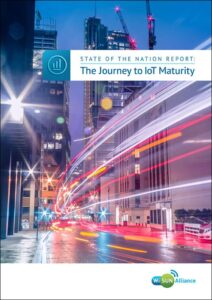The deployment of Internet of Things (IoT) technologies is becoming a higher priority for companies across a variety of sectors, according to a report from the Wi-SUN Alliance, known as “The Journey to IoT Maturity.” Among the 300 decision makers polled for the report, 92 percent indicated they need to invest in IoT technologies within the next 12 months if they want to stay competitive. The industry sectors especially committed to the value of the IoT were technology companies, as well as telecommunications and construction firms.
 However, the organization notes, the report signals challenges ahead. Many respondents questioned the proven return on investment, the complexity of integrating on an IT level, and the costs following financial restraints that resulted from the COVID-19 pandemic. The Wi-SUN Alliance’s research was conducted by technology market research company Vanson Bourne, which interviewed 200 U.S. and 100 U.K. IT decision makers involved in IoT initiatives earlier this year.
However, the organization notes, the report signals challenges ahead. Many respondents questioned the proven return on investment, the complexity of integrating on an IT level, and the costs following financial restraints that resulted from the COVID-19 pandemic. The Wi-SUN Alliance’s research was conducted by technology market research company Vanson Bourne, which interviewed 200 U.S. and 100 U.K. IT decision makers involved in IoT initiatives earlier this year.
In 2017, the Wi-SUN Alliance published its first report on the state of the IoT industry. As with the 2017 report, this year’s study categorized responses according to vertical sectors that have the most to gain from the deployment of IoT solutions. The participants included energy and utilities firms, as well as construction, technology and telecommunications companies. Questions were related to IoT technology overall, rather than specifically Wi-SUN-based systems.
The Wi-SUN Alliance is a global industry association focused on the standard use of IEEE 802.15.4g-based technology. Wi-SUN-based solutions create a mesh network of nodes that communicate at a range of approximately one mile between each other and a gateway. Wi-SUN deployments, traditionally undertaken in the utility market, have grown into smart cities and industrial use cases as well. As deployments continue, the Alliance’s focus is on interoperability of equipment from multiple vendors for use in a single application. Its Wi-SUN certification program provides official designation of interoperability for suppliers, intended to benefit both technology companies and consumers.
The latest study comes as the smart-city industry has greatly evolved during the past five years, according to Phil Beecher, the Wi-SUN Alliance’s president and CEO. Beyond smart cities, the Alliance reports, deployments have been growing in a variety of sectors. One surprising result, Beecher says, was that fewer companies indicated they’d completed an IoT deployment than five years ago. “I was somewhat surprised by the number of organizations that believe they have fully implemented an IoT strategy,” Beecher states. “This time around, that number has decreased.”
Fully Implemented IoT Re-understood
Forty-seven percent of all organizations, the report shows, said they have fully implemented their IoT strategy, in comparison to 55 percent in 2017. That can be explained according to perception, Beecher says, adding, “There is a better understanding what a ‘fully implemented strategy’ is.” Prior to the 2017 report, he explains, many companies were deploying technologies based on “an early win, so they would deploy something early and it worked.” For instance, a utility company could simply automate meter reading.
Now, Beecher says, expectations are rising and companies are seeking more sophistication in their solutions. “So utilities may be moving more from just this automated meter reading,” he explains, “to the integration of renewables, for example, into their smart-meter network.” Those higher aspirations also mean more complex IoT solutions. In smart-city deployments, the report found that 70 percent of those polled have already implemented an IoT initiative, up from 42 percent five years ago.

Phil Beecher
Additionally, the study found new drivers for technology adoption. The need to gain a competitive advantage increased to 10 percent from 6 percent in 2017, while the need to reduce operational costs dropped from 16 percent in 2017 to 6 percent now. A third priority to create business efficiencies has similarly declined, the report noted, from 13 percent five years ago to 11 percent now. This suggests a shift, Beecher says, from using IoT technologies to improve internal processes and operations to viewing the IoT as an opportunity to stand out in the marketplace.
Overall, the number of respondents facing challenges to implementation has fallen, according to the report, while there has been a rise in those admitting it is “extremely difficult “to implement IoT solutions—up to 17 percent, from 14 percent in 2017. This, Beecher says, suggests they may understand the IoT and its uses cases better, but that they have higher expectations of what the technology can achieve.
Security Concerns Reducing
Security remains a concern as well, but it is being viewed differently five years after the first report. About a quarter of all respondents consider security to be one of the top three barriers to IoT adoption, down from 58 percent five years ago. Such results may reflect the fact that people were worried about possible security architecture concerns more in the past—whereas now, Beecher says, the same decision makers are “more mature in their recognition of what they need to do in terms of securing a network.”
A hybrid approach to IoT deployments is front and center for many companies, the report indicated. That means considering Wi-SUN technology’s benefits related to wireless mesh networking, Beecher says, while including other technologies, such as cellular for backhaul connectivity. “That was good news for me,” he states, “because it means that we’ve taken the correct approach for the previous five years [toward open interoperability] and supporting hybrid networks with a mix of communications technologies.”
The report found growth in smart initiatives as well. Security and surveillance are the most likely IoT use cases to be rolled out, according to the study, with 87 percent of respondents very likely or definitely planning to deploy the technology within the next 12 to 18 months, up from 77 percent in 2017. This is followed by distribution automation (82 percent, compared to 74 percent five years) and advanced meter infrastructure (80 percent, as opposed to 68 percent in on the prior study).
Smart parking has achieved the greatest rise since 2017, up from 57 percent to 77 percent, along with traffic lights and controls—76 percent now, but just 58 percent previously. Noise and air sensors, along with electric vehicle charging, have seen similar growth. Another influencer for decision makers for the 2022 report has been the pandemic, with more than a third indicating the coronavirus has had an impact on project rollouts due to a loss of revenue.
For the Wi-SUN Alliance, the report is a measure of industry growth that the organization has watched occur around it. When the Alliance launched approximately a decade ago, Beecher recalls, two utility companies drove the efforts for a standard in communication technology, which became IEEE 802.15.4g. Since then, its membership has grown to 320 companies throughout 46 countries. These days, many millions of smart meters employ the technology globally.
Smart Life Preservers in London
The expansion from smart metering has been, in large part, into smart-city deployments. For instance, the City of London is using the Wi-SUN standard for its lighting controls. London’s narrow streets and high-rise steel and glass buildings posed challenges for traditional cellular connectivity, so administrators deployed the mesh Wi-SUN nodes on its LED luminaires that light the entire city. Since then, London has found ways to further leverage the existing mesh network.
Officials have added Wi-SUN sensors to the life preservers secured along the banks of the River Thames, for example. These life preservers can be used if somebody falls into the river, so the city wanted a system that could track the life-saving devices and ensure they would not be removed. The sensors communicate with the network via the mesh nodes installed on the streetlights, and if one is removed, the city knows in real time that this has occurred and can thus rectify the problem.
Key Takeaways:
- The study finds greater maturity and confidence in IoT systems.
- Hybrid approaches and interoperable technologies may enable the IoT to solve increasingly complex challenges.
Exhibitors at RFID Journal LIVE! 2022 will offer a wide variety of Internet of Things solutions. To learn more, visit the event’s website.


